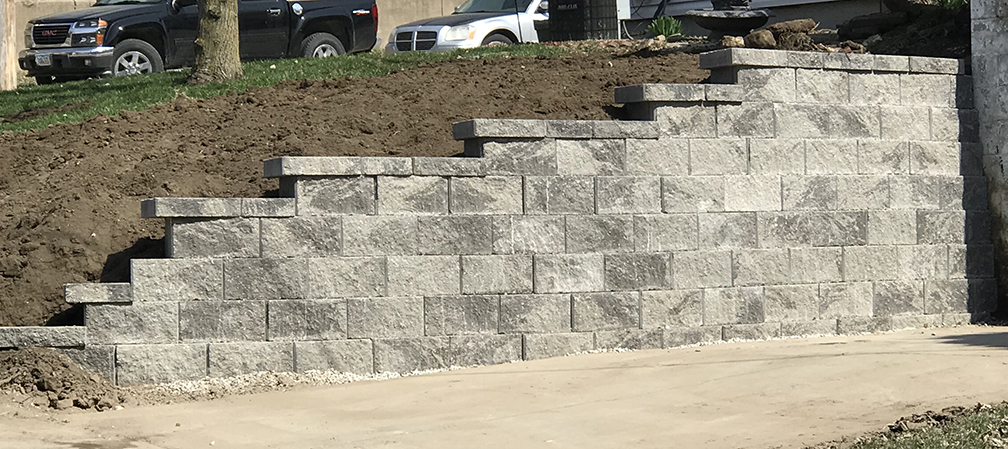Retaining Walls
Retaining walls basically do one thing, hold soil behind them. This may be as simple as a one foot high wall outlining a planting area or it may include a series of tiered walls holding back a hill.
There are a variety of factors that have to be consider when we think about what kind and type of retaining wall to install. The application, desired outcome, water flow, and aesthetic will impact the type and kind of wall that can be considered.
If you’re looking at having a new retaining wall installed or an old retaining wall replaced you probably have already asked yourself, “what you want the new wall to look like?”. Before you jump right to the aesthetics of your new retaining wall we first need to understand your location, the total environment around the retaining wall, the amount and type of soil the wall needs to contain, the number of gallons of water interacting with the wall during a heavy storm, does the wall need to contain and stop erosion.
How will the wall impact maintenance and the area’s use? All of these factors and more go into the effective planning of adding a retaining wall.
If the project is on any type of slope, water drainage becomes a major factor in considering retaining wall design and implementation. Water is the most common reason retaining walls fail, it either retains water not letting it escape which builds up hydrostatic pressure, water pools, and/or erodes around the wall and footing causing the wall to eventually fail. It’s critical to make sure your new retaining wall has proper drainage and that we provide an escape route for water away from building foundations and the wall itself. The area around your wall may need to be regraded to create a drainage system behind the wall to minimize the amount of hydrostatic pressure ground water can create. We then have to consider any environmental impact this change in drainage might have down stream to your property or your neighbors. Planning water migration is a base element that has to be designed into any successful retaining wall project. It may be as simple as gravel backfill or the use of drain tiles or weep holes but how you’re going to deal with water is critical.
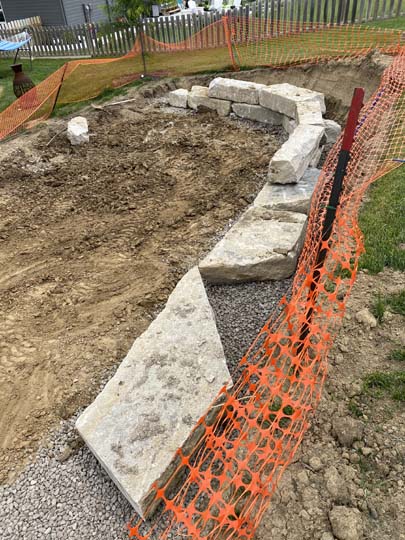

Thinking about having a Retaining Wall Installed?
We'll give you a Free No Hassle Estimate!Who you use matters.
Our experience, knowledge and guarantee, insure our walls will stand the test of time!
Joseph Faust Enterprises
Omaha & Council Bluffs - Retaining Wall ProsWill provide you with a complete, detailed no hassle estimate including a timeline of when we can start and when your project should be completed.


Wall location is the second thing to consider, making sure everyone understanding property lines, above ground and below ground utilities, storm drains, irrigation systems and any thing else we will have to work around or relocate to be able to install the retaining wall. Will there be additional load forces above the wall like fencing, guard rails, driveways, parking lots or swimming pools? In the future adding a swimming pool or parking lot above a retaining wall will significantly increase load forces pushing against the wall and should be considered before a project begins.
The type of soil the wall is containing will also impact its design and the type of material recommended. In general the base soil needs to be a solid firm soil. Things like soil bearing capacity, it’s ability to support a load, friction angle of the soil and other stress parameters need to be accounted for. Soil can’t be over saturated or wet, wet soils like clays are already saturated with water so additional moisture can’t make it way through to the drainage channels. In Omaha and Council Bluffs, we see several freeze thaw cycles per year which causes expansion and contraction, soils that hold excessive moisture can cause damage to the water drainage system or the retaining wall. Sandy soil’s allow for good water drainage, and will be brought in if needed.
Effective design also takes into account the wall height, slope, wall footprint size, and setback angle which are dependent upon the site elevation and grade. Realize that gravity is a constant force and will cause the soil behind the retaining wall to naturally move downslope. This force should be counteracted within the design to minimize the amount of lateral earth pressure behind the wall to insure over time the wall does not move. Today’s superior building techniques and products allow us to build walls that are reinforced so gravity doesn’t win overtime.
Wall location is the second thing to consider, making sure everyone understanding property lines, above ground and below ground utilities, storm drains, irrigation systems and any thing else we will have to work around or relocate to be able to install the retaining wall. Will there be additional load forces above the wall like fencing, guard rails, driveways, parking lots or swimming pools? In the future adding a swimming pool or parking lot above a retaining wall will significantly increase load forces pushing against the wall and should be considered before a project begins.
The type of soil the wall is containing will also impact its design and the type of material recommended. In general the base soil needs to be a solid firm soil. Things like soil bearing capacity, it’s ability to support a load, friction angle of the soil and other stress parameters need to be accounted for. Soil can’t be over saturated or wet, wet soils like clays are already saturated with water so additional moisture can’t make it way through to the drainage channels. In Omaha and Council Bluffs, we see several freeze thaw cycles per year which causes expansion and contraction, soils that hold excessive moisture can cause damage to the water drainage system or the retaining wall. Sandy soil’s allow for good water drainage, and will be brought in if needed.
Effective design also takes into account the wall height, slope, wall footprint size, and setback angle which are dependent upon the site elevation and grade. Realize that gravity is a constant force and will cause the soil behind the retaining wall to naturally move downslope. This force should be counteracted within the design to minimize the amount of lateral earth pressure behind the wall to insure over time the wall does not move. Today’s superior building techniques and products allow us to build walls that are reinforced so gravity doesn’t win overtime.

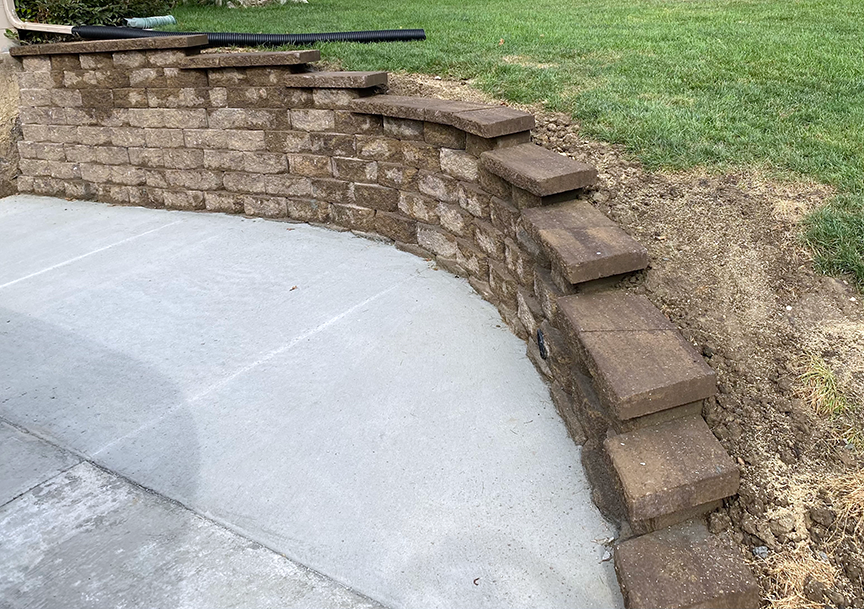
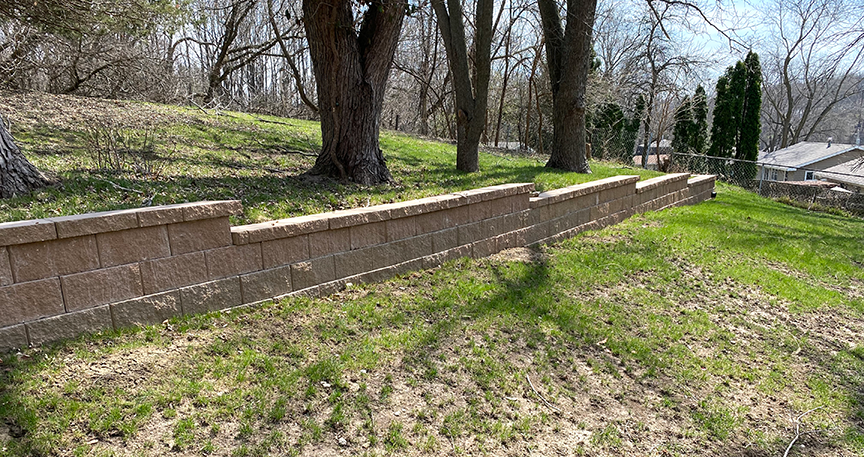

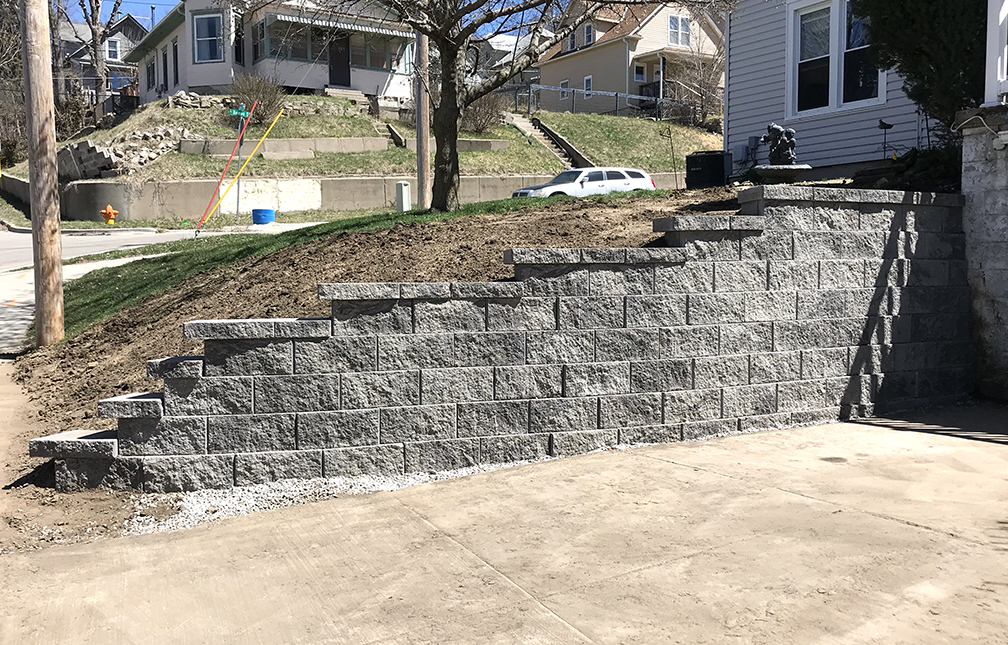
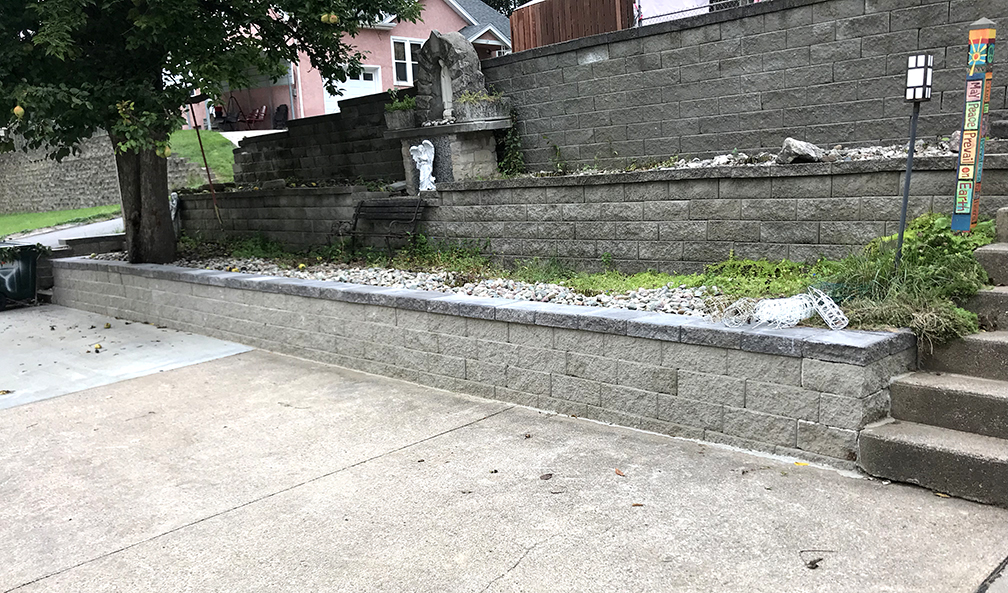
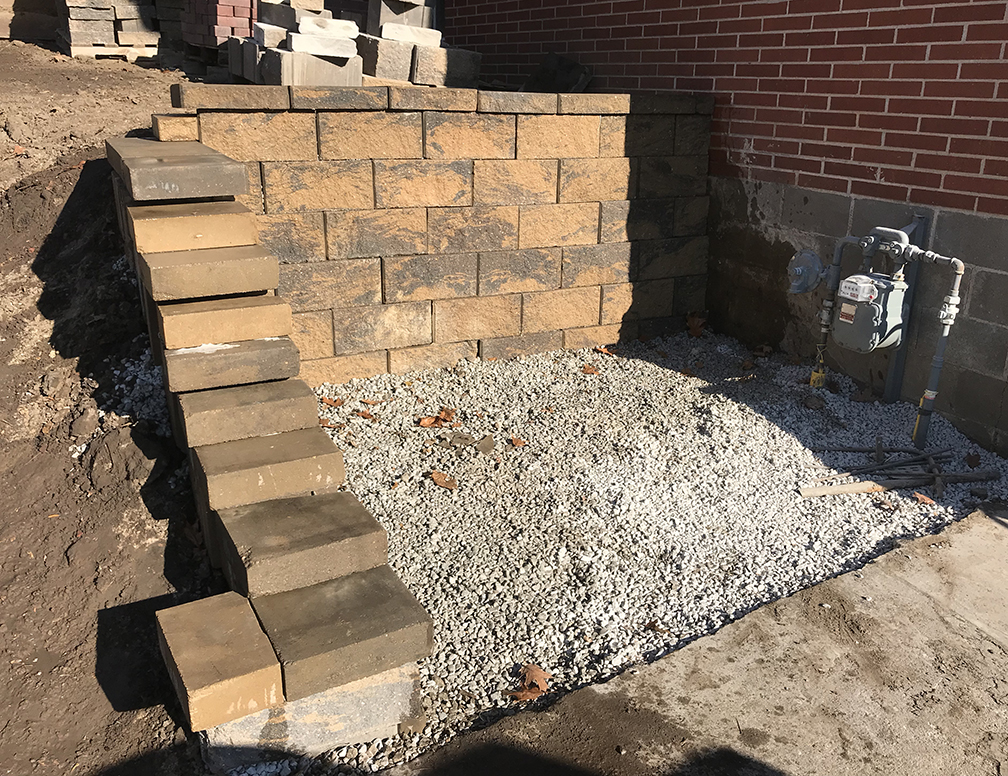
Retaining Wall Types and additional uses
Now that we’ve looked at most of the technical requirements for building a solid retaining wall that will stand the test of time, we can begin looking at the aesthetics of your new retaining wall. How long is the retaining wall? Is it straight or should it have some natural curves? What are the best materials and do they require reinforcing?
There are many different types of retaining walls available. While we have experience with almost all of them, we have found that some are used more ofter than others. The types of walls we will be looking at are, block walls, large block walls, concrete block walls, stone walls, interlocking block walls, paver walls, cinder block walls, natural stone walls, flagstone walls, beam rock, chopped brown brick, limestone walls.
Retaining walls are not only crucial for holding back soil but also play a vital role in diverting water away from foundations, thus protecting structural integrity. Here’s an in-depth look at some popular man-made block systems, which combine aesthetics with functionality, suitable for various residential and commercial projects.
Anchor – Diamond Pro 8″ Block Face Retaining Wall System, is one of the most popular man-made blocks. These blocks come in a variety of colors like granite, gray, mocha, and Sahara. Manufactured with a bottom lip that guarantees precise setback, these blocks can be reinforced by adding concrete inside the wall, which is recommended for walls over 4 feet high. Their uniformity makes them an ideal building material for retaining walls, planting areas, and steps. The blocks come in both straight and beveled faces and can be used on small to very large projects.
Anchor – Diamond 10D Block, is ideal for building around curves, straight or terraced walls. Providing a natural block look similar to the Diamond Pro 8″ Block, this block is well suited for steps, corners, planters, fire features, and retaining walls. It too comes in chestnut, gray, mocha, and Sahara, with both straight and beveled block options.
Anchor – Highland Stone Retaining Wall System, comes in a slightly wider color palette and is often mistaken for a natural stone product. This stone look uses earthen tones, varied contours, and rich textures to fool your eye. Also featuring the Anchor back bottom lip for precise setback, these blocks create a beautiful hand-stacked random pattern. Very popular in patio and outdoor living spaces, the variety of sizes available makes these blocks very popular when the retaining wall design requires more complex angles.
Versa-Lok Standard, is another well-established man-made supplier of natural stone-looking block. As the name suggests, these blocks lock together creating a solid, anchored retaining wall system. This solid top pinning segmental retaining wall system provides a long-lasting durable option with all the design options including curves, corners, stairs, columns, and even freestanding walls. Available in six color choices, this block comes in prairie tan, natural gray, brownstone, charcoal, chestnut, and rose creek.
Versa-Lok Cobble is a little smaller and lighter than the Versa-Lok Standard block with provides an enormous amount of design flexibility. About half the size of the Versa-Lok Standard wall block, the Cobble blocks are perfect for planters, smaller retaining walls, and garden projects. Smaller and lighter than it’s bigger brother the Standard unit, the Cobble wall units retain the same proven top down pinning system, guaranteeing solid long lasting construction.
Versa-Lok Mosaic Retaining Wall System allow you to create eye-catching designs by combining Versa-Lok standard, cobble and accent units in one wall. The Mosaic System uses four different block sizes to create a unique interesting wall every time. This unique design application allows us to create complex stone patterns that look like ancient stone walls. They also come in a Mosaic Grande color which create a more random color pattern throughout the retaining wall.
Versa-Lok Harmony Blocks are the same size and shape as the Standard, Cobble and Mosaic with a natural brown stone look.
Chopped Limestone, comes in natural or tumbled stackers. As a natural stone Limestone come in a wide variety of colors. Depending on how the Limestone is cut can greatly affect the wall face finish and texture. As one of the most ancient stone building materials limestone has been used for retaining walls. Chopped Limestone blocks are sawn smooth on the top and bottom with natural cut sides so that material can be consistently stacked on the smooth sawn cut face. Since Limestone does not come in a uniform size, retaining walls made of Limestone are large puzzles fit together to create a natural eye catching look. Limestone walls often take longer to construct and cost more.
Flagstone, is another naturally occurring stone that has been used in retaining wall construction for centuries. Actually Flagstone is a generic term for a sedimentary stone that is split into layers. Flagstone can be Sandstone, Travertine, Limestone, Slate, Bluestone, or Quartzite. Traditionally Flagstone is used in shorter walls usually less than three or four feet high, because it is cut into layers which make each stone lighter. Because Flagstone is usually only a few inches thick it creates a very natural old world look.
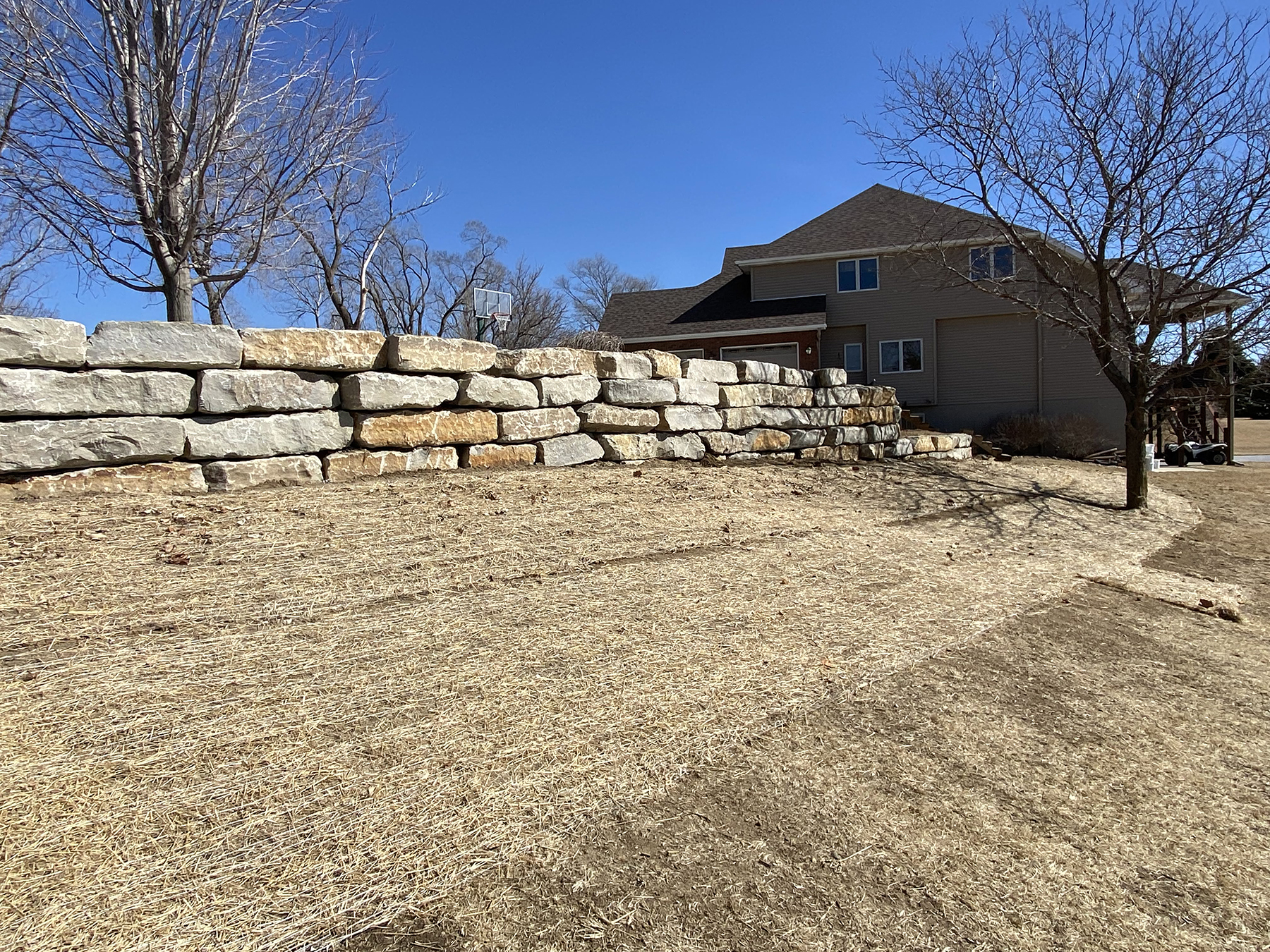
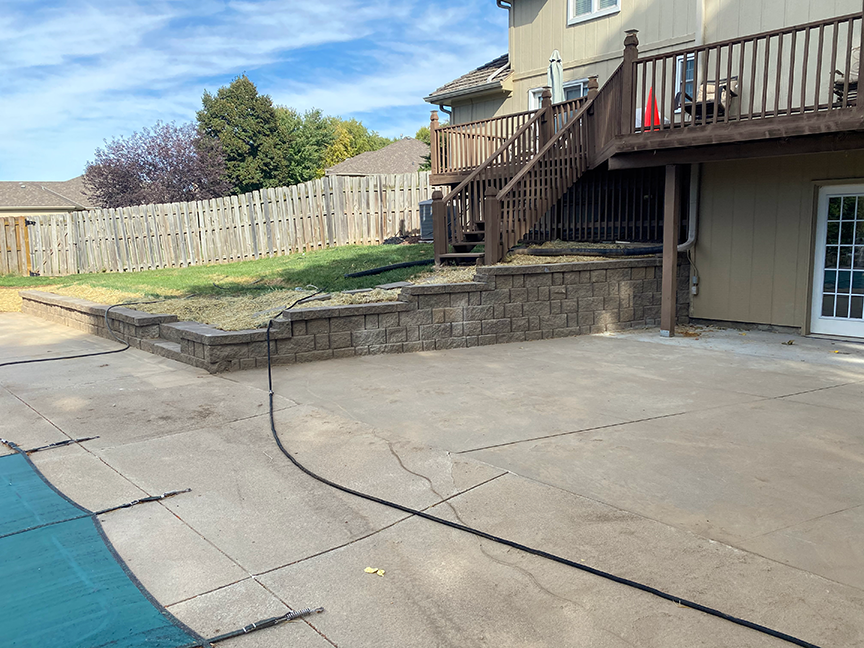
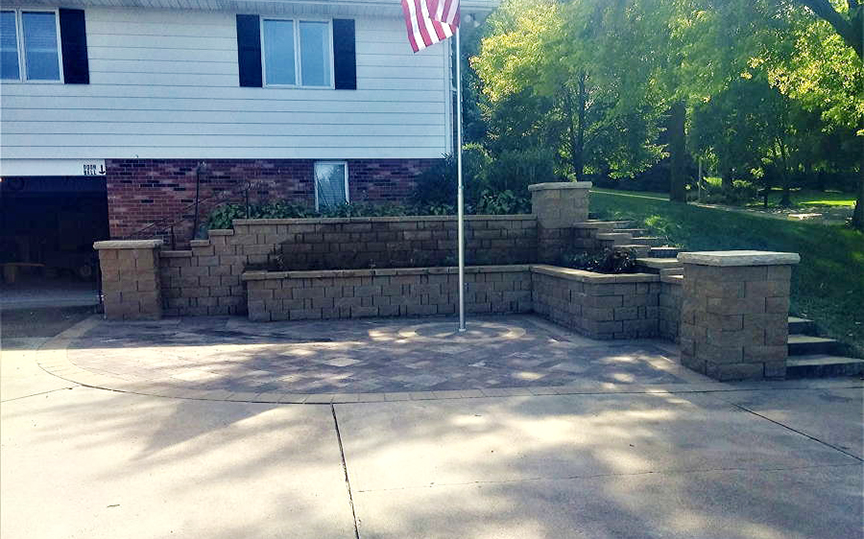
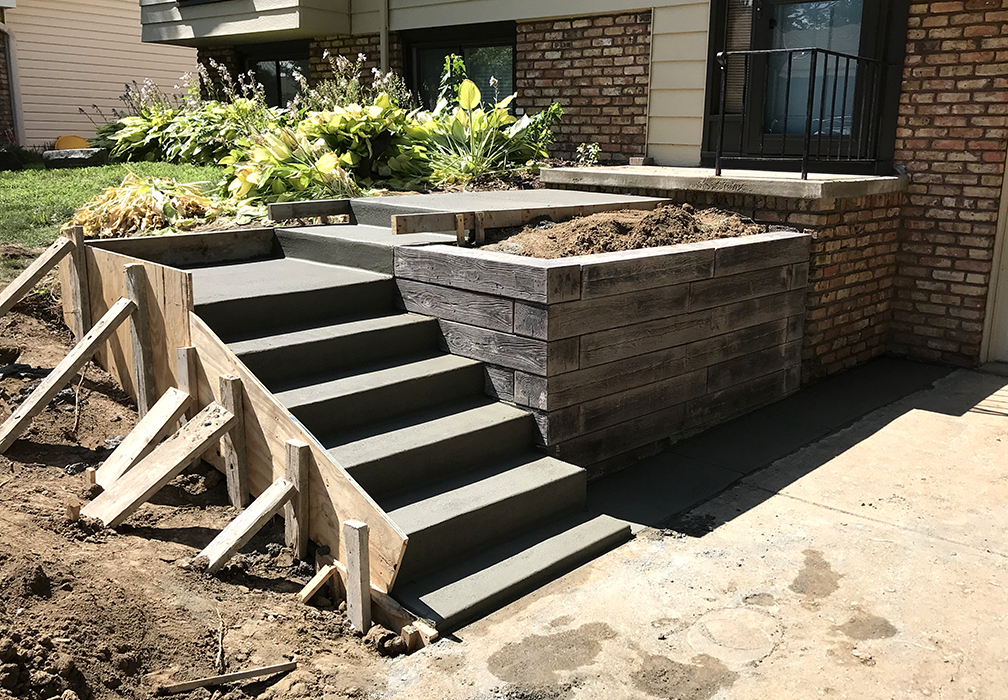
In addition to these aesthetic and functional products, it is important to understand the various types of retaining walls that serve specific engineering functions to effectively divert water from foundations:
Gravity Retaining Walls use their mass, typically constructed from stone or concrete, to resist the lateral pressure of the soil. The base is wider and often leans back toward the retained soil to enhance stability.
Anchored Retaining Walls involve not just mass but also mechanical reinforcement, typically through the use of cables or rods that are anchored into the soil or rock behind the wall. These are particularly useful in areas where space constraints prevent the use of wider, gravity-based systems.
Cantilevered Retaining Walls extend the principle of the gravity wall by using a concrete foundation that projects into the base soil. The cantilever design allows for less material usage while maintaining strong structural support, especially pertinent where the frost line is deep.
Sheet Pile Retaining Walls are employed where ground space is limited or the soils are loose and water-saturated. These walls are driven deep into the ground and often reinforced with anchoring systems to provide additional stability.
Understanding the variety of retaining wall options, both in terms of aesthetic appeal and structural functionality, is crucial for selecting the right system to protect your property from water damage and soil erosion effectively.
What preparation steps should be taken before diverting water with a retaining wall?
Water drainage becomes a major factor in considering retaining wall design and implementation. Before embarking on your retaining wall project, it’s essential to observe the natural flow of water across your intended site. This initial step will help you understand how water interacts with the terrain, which is crucial for planning effective water diversion. Assess the direction you intend to redirect the water, ensuring that this redirection does not adversely affect other structures like your home’s foundation or driveway.
Water is the most common reason retaining walls fail; it either retains water, not letting it escape, which builds up hydrostatic pressure, or water pools and/or erodes around the wall and footing causing the wall to eventually fail. It’s critical to make sure your new retaining wall has proper drainage and that we provide an escape route for water away from building foundations and the wall itself. The area around your wall may need to be regraded to create a drainage system behind the wall to minimize the amount of hydrostatic pressure groundwater can create. We then have to consider any environmental impact this change in drainage might have downstream to your property or your neighbors. Planning water migration is a base element that has to be designed into any successful retaining wall project. It may be as simple as gravel backfill or the use of drain tiles or weep holes but how you’re going to deal with water is critical.
Similarly, foundation maintenance requires careful consideration of water management. The key is to maintain even soil moisture levels around your foundation to prevent structural issues such as heaving, shifting, and cracking. This begins with ensuring that the soil slopes away from the foundation, allowing water to drain off rather than accumulate. Over time, factors like soil erosion can diminish this slope, allowing water to pool near the structure. Conversely, silt accumulation can create uneven soil build-up, directing water in unpredictable patterns around and beneath the foundation. Both scenarios lead to uneven moisture levels that compromise the integrity of the foundation. Therefore, when planning any construction or landscaping project, it’s essential to integrate effective water control measures that address both immediate and long-term needs of retaining walls and foundational support
By taking these steps, you ensure that your retaining wall stands up to pressure, avoids failure, and effectively manages water flow, thereby securing the integrity and functionality of both the wall and surrounding structures.
Common Questions
What are the different types of retaining walls that can be used to divert water from foundations?
Retaining walls are not only crucial for holding back soil but also play a vital role in diverting water away from foundations, thus protecting structural integrity. Here’s an in-depth look at some popular man-made block systems, which combine aesthetics with functionality, suitable for various residential and commercial projects.
**Anchor – Diamond Pro 8" Block Face Retaining Wall System** is one of the most popular man-made blocks. These blocks come in a variety of colors like granite, gray, mocha, and Sahara. Manufactured with a bottom lip that guarantees precise setback, these blocks can be reinforced by adding concrete inside the wall, which is recommended for walls over 4 feet high. Their uniformity makes them an ideal building material for retaining walls, planting areas, and steps. The blocks come in both straight and beveled faces and can be used on small to very large projects.
**Anchor – Diamond 10D Block** is ideal for building around curves, straight or terraced walls. Providing a natural block look similar to the Diamond Pro 8" Block, this block is well suited for steps, corners, planters, fire features, and retaining walls. It too comes in chestnut, gray, mocha, and Sahara, with both straight and beveled block options.
**Anchor – Highland Stone Retaining Wall System** comes in a slightly wider color palette and is often mistaken for a natural stone product. This stone look uses earthen tones, varied contours, and rich textures to fool your eye. Also featuring the Anchor back bottom lip for precise setback, these blocks create a beautiful hand-stacked random pattern. Very popular in patio and outdoor living spaces, the variety of sizes available makes these blocks very popular when the retaining wall design requires more complex angles.
**Versa-Lok Standard** is another well-established man-made supplier of natural stone-looking block. As the name suggests, these blocks lock together creating a solid, anchored retaining wall system. This solid top pinning segmental retaining wall system provides a long-lasting durable option with all the design options including curves, corners, stairs, columns, and even freestanding walls. Available in six color choices, this block comes in prairie tan, natural gray, brownstone, charcoal, chestnut, and rose creek.
In addition to these aesthetic and functional products, it is important to understand the various types of retaining walls that serve specific engineering functions to effectively divert water from foundations:
**Gravity Retaining Walls** use their mass, typically constructed from stone or concrete, to resist the lateral pressure of the soil. The base is wider and often leans back toward the retained soil to enhance stability.
**Anchored Retaining Walls** involve not just mass but also mechanical reinforcement, typically through the use of cables or rods that are anchored into the soil or rock behind the wall. These are particularly useful in areas where space constraints prevent the use of wider, gravity-based systems.
**Cantilevered Retaining Walls** extend the principle of the gravity wall by using a concrete foundation that projects into the base soil. The cantilever design allows for less material usage while maintaining strong structural support, especially pertinent where the frost line is deep.
**Sheet Pile Retaining Walls** are employed where ground space is limited or the soils are loose and water-saturated. These walls are driven deep into the ground and often reinforced with anchoring systems to provide additional stability.
Understanding the variety of retaining wall options, both in terms of aesthetic appeal and structural functionality, is crucial for selecting the right system to protect your property from water damage and soil erosion effectively.
What preparation steps should be taken before diverting water with a retaining wall?
Water drainage becomes a major factor in considering retaining wall design and implementation. Before embarking on your retaining wall project, it's essential to observe the natural flow of water across your intended site. This initial step will help you understand how water interacts with the terrain, which is crucial for planning effective water diversion. Assess the direction you intend to redirect the water, ensuring that this redirection does not adversely affect other structures like your home’s foundation or driveway.
Water is the most common reason retaining walls fail; it either retains water not letting it escape which builds up hydrostatic pressure, water pools, and/or erodes around the wall and footing causing the wall to eventually fail. It’s critical to make sure your new retaining wall has proper drainage and that we provide an escape route for water away from building foundations and the wall itself. The area around your wall may need to be regraded to create a drainage system behind the wall to minimize the amount of hydrostatic pressure groundwater can create.
In addition to these considerations, it is important to choose the right materials for the backfill behind your retaining wall. Clay soils, for instance, retain water for a long time, which can exert undue pressure against the wall. On the other hand, sandy soils and small rocks or gravel allow water to drain more easily, reducing pressure and enhancing stability.
We then have to consider any environmental impact this change in drainage might have downstream to your property or your neighbors. Planning water migration is a base element that has to be designed into any successful retaining wall project. It may be as simple as gravel backfill or the use of drain tiles or weep holes but how you’re going to deal with water is critical.
By taking these steps, you ensure that your retaining wall stands up to pressure, avoids failure, and effectively manages water flow, thereby securing the integrity and functionality of both the wall and surrounding structures.
What are some common issues related to water runoff around foundations?
Why is it important to maintain even soil moisture levels around foundations?
Maintaining even soil moisture levels is crucial to prevent structural damage to foundations, as fluctuations can lead to significant issues that compromise the integrity and stability of the building.
What causes uneven soil moisture levels around a foundation?
Uneven soil moisture levels are primarily caused by soil erosion, which removes the protective slope, and silt accumulation, which can alter the drainage pattern, both resulting from inadequate handling of water runoff.
What are the direct consequences of uneven water drainage around a foundation?
Uneven water drainage can lead to various forms of foundation damage, including heaving, shifting, and cracking of the foundation itself, as these issues arise from the uneven moisture levels in the soil surrounding the foundation.
How does water runoff affect soil moisture levels around foundations?
Water runoff, when not properly managed, can lead to uneven soil moisture levels by either causing soil erosion or allowing for the accumulation of silt. These conditions disrupt the intended slope and drainage away from the foundation.
Additionally, retaining walls play a pivotal role in diverting water away from foundations, thereby controlling erosion, managing runoff, and preventing the accumulation of silt. By strategically placing these structures, we can reroute the neighbor’s runoff rivers, slow down silt accumulation, and prevent water from washing away valuable landscaping soil. Retaining walls thus serve not only as a physical barrier but also as an integral part of a wider water flow management solution. When combined with proper guttering systems, French drains, and foundation swales, retaining walls effectively divert water away from the foundation, ensuring that the ground remains stable and your home is protected from potential water damage. This comprehensive approach is essential in maintaining the integrity of both the retaining wall and the home’s foundation during adverse weather conditions.
In Summary
Most retaining walls are more a need than an aesthetic feature in your yard. While a retaining wall holds back soil there is absolutely no reason why a retaining wall doesn’t add beauty and functionality to your property while fixing what ever problems the natural slope of the property creates.
As you consider your options in material and functionality keep in mind these design and engineering requirements to guarantee you new retaining wall will stand the test of time.
Build on a solid base. Contractors and engineers stress the importance of starting a building project on a good base. The base should be constructed below ground level, and made of compact sand and gravel, or concrete. The type of base or wall footing will depend on the walls required function and size. Here in the Omaha, Nebraska – Council Bluffs, Iowa area the ground freezes solid every year. Depending on the ground moisture when it freezes the freeze thaw cycle can apply tremendous force to a wall base or footing.
Be sure the wall is backfilled correctly. Backfill is the dirt behind the wall. In order to provide proper drainage, at least 12 inches of granular backfill (gravel or a similar aggregate) should be installed directly behind the wall.
Drainage is critical, because most retaining walls are impervious, which means water can not pass through the wall. Hydrostatic pressure is a major reason walls fail, water is heavy, 8 lbs per gallon so providing an escape route for the water behind retaining wall can be the difference between success or failure.
Wall height determines the load it the wall must bear and how much extra reinforcement is required. If the wall requires reinforcement, extra anchors, cantilevers or specially designed reinforcement brackets can do the trick.
No doubt about it, retaining walls are complex structures dealing with tremendous forces and must be constructed properly. They can add a tremendous amount of beauty and functionality to your property. If you’re thinking that you need to either upgrade replace or have a new wall installed on your property we would be honored to have the opportunity to provide you with a free estimate and explain to you why JFE Lawn and Landscape is the right company to do the job.
